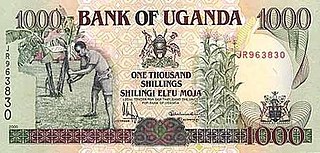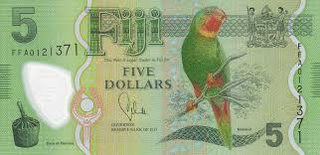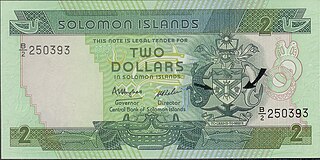
The New Zealand dollar is the official currency and legal tender of New Zealand, the Cook Islands, Niue, the Ross Dependency, Tokelau, and a British territory, the Pitcairn Islands. Within New Zealand, it is almost always abbreviated with the dollar sign ($). The abbreviations "$NZ" or "NZ$" are used when necessary to distinguish it from other dollar-denominated currencies.
The dollar has been the currency of The Bahamas since 1966. It is normally abbreviated with the dollar sign $, or alternatively B$ to distinguish it from other dollar-denominated currencies. It is divided into 100 cents.

The Namibia dollar has been the currency of Namibia since 1993. It is normally abbreviated with the dollar sign ($), or alternatively N$ to distinguish it from other currencies called “dollar.” It is divided into 100 cents.

The Sri Lankan Rupee is the currency of Sri Lanka. It is subdivided into 100 cents, but cents are rarely seen in circulation due to its low value. It is issued by the Central Bank of Sri Lanka. The abbreviation Re (singular) and Rs (plural) is generally used, the World Bank suggests SL Rs as a fully disambiguating abbreviation for distinction from other currencies named "rupee".

The pula is the currency of Botswana. It has the ISO 4217 code BWP and is subdivided into 100 thebe. Pula literally means "rain" in Setswana, because rain is very scarce in Botswana—home to much of the Kalahari Desert—and therefore valuable and a blessing. The word also serves as the national motto of the country.
The leone is the currency of Sierra Leone. It is subdivided into 100 cents. As of 1 July 2022, the ISO 4217 code is SLE due to a redenomination of the old leone (SLL) at a rate of SLL 1000 to SLE 1. The leone is abbreviated as Le placed before the amount.

The pound, or lira, was the currency of Cyprus, including the Sovereign Base Areas in Akrotiri and Dhekelia, from 1879 to 2007, when the Republic of Cyprus adopted the euro. However, the self-proclaimed Turkish Republic of Northern Cyprus uses the Turkish lira as its official currency.

The manat is the currency of Turkmenistan. The original manat was introduced on 1 November 1993, replacing the rouble at a rate of 1 manat = Rbls 500. The manat is subdivided into 100 tenge.

The Cuban peso also known as moneda nacional, is the official currency of Cuba.

The shilling is the currency of Uganda. Officially divided into cents until 2013, due to substantial inflation the shilling now has no subdivision.

The shilling is the currency of Tanzania. It is subdivided into 100 cents . The Tanzanian shilling replaced the East African shilling on 14 June 1966 at par.
The Bermudian dollar is the official currency of the British Overseas Territory of Bermuda. It is subdivided into 100 cents. The Bermudian dollar is not normally traded outside Bermuda, and is pegged to the United States dollar at a one-to-one ratio. Both currencies circulate in Bermuda on an equal basis.

The Fijian dollar has been the currency of Fiji since 1969 and was also the currency between 1867 and 1873. It is normally abbreviated with the dollar sign $, or alternatively FJ$ to distinguish it from other dollar-denominated currencies. It is divided into 100 cents.

The Jamaican dollar has been the currency of Jamaica since 1969. It is often abbreviated to J$, the J serving to distinguish it from other dollar-denominated currencies. It is divided into 100 cents, although cent denominations are no longer in use as of 2018. Goods and services may still be priced in cents, but cash transactions are now rounded to the nearest dollar.

The Guyanese dollar has been the unit of account in Guyana since 29 January 1839. Originally it was intended as a transitional unit to facilitate the changeover from the Dutch guilder system of currency to the British pound sterling system. The Spanish dollar was already prevalent throughout the West Indies in general, and from 1839, the Spanish dollar unit operated in British Guiana in conjunction with British sterling coins at a standard conversion rate of one dollar for every four shillings and twopence. In 1951 the British sterling coinage was replaced with a new decimal coinage which was simultaneously introduced through all the British territories in the Eastern Caribbean. When sterling began to depreciate in the early 1970s, a switch to a US dollar peg became increasingly attractive as an anti-inflationary measure and the Eastern Caribbean Currency Authority made the switch in October 1975. The Guyanese dollar is normally abbreviated with the dollar sign $, or alternatively G$ to distinguish it from other dollar-denominated currencies.

The Solomon Islands dollar is the currency of Solomon Islands since 1977. Its symbol is $, with SI$ used to differentiate it from other currencies also using the dollar sign. It is subdivided into 100 cents.

The Rwandan franc is the currency of Rwanda.

The guilder was the currency of Suriname until 2004, when it was replaced by the Surinamese dollar. It was divided into 100 cents. Until the 1940s, the plural in Dutch was cents, with centen appearing on some early paper money, but after the 1940s the Dutch plural became cent.

The Cook Islands dollar was the former currency of the Cook Islands, which now uses the New Zealand dollar, although some physical cash issued for the Cook Islands dollar remains in use. The dollar was subdivided into 100 cents, with some older 50-cent coins carrying the denomination as "50 tene".
The coins of the New Zealand dollar are used for the smallest physical currency available in New Zealand. The current denominations are ten cents, twenty cents, fifty cents, one dollar and two dollars. The $1 and $2 coins are minted in a gold colour, the 20c and 50c coins are silver colour and the 10c coin is plated in copper.

















